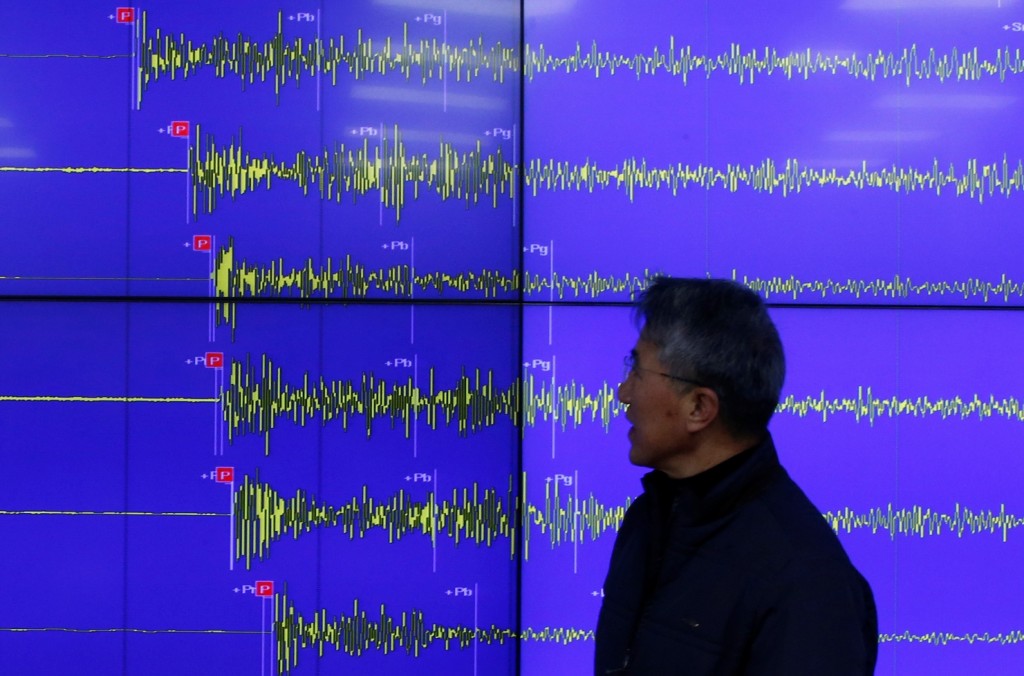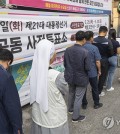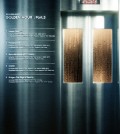- California Assembly OKs highest minimum wage in nation
- S. Korea unveils first graphic cigarette warnings
- US joins with South Korea, Japan in bid to deter North Korea
- LPGA golfer Chun In-gee finally back in action
- S. Korea won’t be top seed in final World Cup qualification round
- US men’s soccer misses 2nd straight Olympics
- US back on track in qualifying with 4-0 win over Guatemala
- High-intensity workout injuries spawn cottage industry
- CDC expands range of Zika mosquitoes into parts of Northeast
- Who knew? ‘The Walking Dead’ is helping families connect
Nuclear experts doubt North Korea’s successful H-bomb test claims

Earthquake and Volcano of the Korea Meteorological Administration Director General Yun Won-tae stands in front of a screen showing seismic waves that were measured in South Korea, in Seoul Wednesday, Jan. 6, 2016. North Korea said it conducted a powerful hydrogen bomb test Wednesday, a defiant and surprising move that, if confirmed, would be a huge jump in Pyongyang’s quest to improve its still-limited nuclear arsenal. (AP Photo/Lee Jin-man)
By Chang Jae-soon
WASHINGTON (Yonhap) — U.S. nuclear experts doubted North Korea’s claims of a successful H-bomb test on Wednesday, saying its yield is too low to believe that such an advanced bomb, way more powerful than conventional nuclear weapons, has been detonated.
“It is likely that this was not a test of what in the popular literature is interpreted as an H-Bomb, namely a two-stage fission-fusion weapon developed by the major nuclear-weapon states capable of obtaining explosive yields of hundreds or thousands of kilotons,” said David Albright, a nuclear expert heading the Institute for Science and International Security in Washington.
South Korea’s spy agency believes that the yield of Wednesday’s test is 6 kilotons and a 4.8-magnitude temblor was detected. In comparison, the yield of the nuclear device North Korea tested in 2013 was 7.9 kilotons and it caused a 4.9-magnitude earthquake.
“If North Korea had indeed tested this type of H-bomb, the device’s yield would be expected to be many tens of kilotons, at least,” Albright said.
The communist nation could have intentionally limited the device’s yield, instead of detonating the weapon at its full potential yield, in order to contain the underground explosion and prevent radioactive releases from the test site, the expert said.
Even if so, however, the yield of a two-stage H-Bomb test would have been much higher, he said.
In addition, Albright also noted that the development of a two-stage thermonuclear weapon is “very challenging,” beyond the North’s capabilities at this stage.
“On balance, it is not believed that North Korea tested a two-stage H-bomb,” he said.
Albright said the North could have blasted a one-stage device whose design is easier to achieve than a two-stage weapon and can achieve very high explosive yields. Nonetheless, the yield of a one-stage thermonuclear device would also be expected to have been larger than reported so far, he said.
However, the expert stressed that the North’s claims “should not be discounted completedly” since it has been investigating thermonuclear materials and concepts for some time.
“While awaiting success, North Korea can bluff. It can claim that it now knows how to achieve high yields with thermonuclear concepts,” he said. “It is difficult to prove it does not.”
The expert called for pressure on Pyongyang to end its nuclear program.
“A priority must be to find ways to both further pressure North Korea to limit its nuclear weapons capabilities and engage it diplomatically to halt and eventually end its nuclear weapons program,” Albright said.
“In this environment of North Korean advancements and little prospect of negotiations … Congress should act,” he said. “It should pass bipartisan financial and secondary sanctions legislation that increases the costs on North Korea.”
Jeffrey Lewis, a nonproliferation expert and director of the East Asia Nonproliferation Program at the James Martin Center for Nonproliferation Studies (CNS), also expressed doubts about the North’s claims.
“The event seems too small to have been a classic thermonuclear device,” he said, adding that it may have been a boosted device. “Much depends on the final estimate of the size of the explosion, which is very uncertain at the moment,” he said.
















